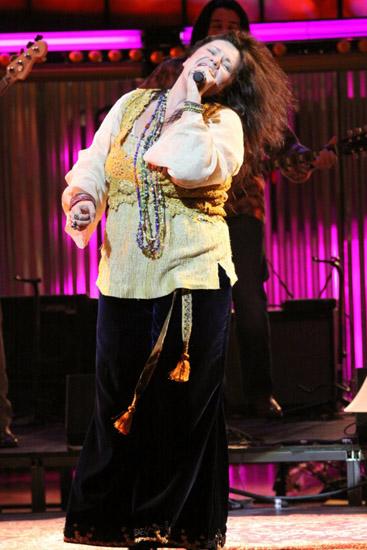Authentic, Emotional Davies Becomes Janis Joplin for the Night at Arena
By • November 6, 2012 0 1649

Opening nights in the theater are always fraught with a certain danger, an intensity—and intenseness—of feeling that probably won’t occur later during the normal run of a show or production.
That was especially true in the case of “One Night With Janis Joplin,”, the Arena Stage-Cleveland Playhouse biographical showcase of the life, time and roots of the 1960s blues-rock singer-become-legend who died of an overdose in 1970 at the age of 27.
The opening night performance had an electric feel to it, a wobbly-time-machine feel, and an almost total willingness on the part of the audience to join in, dive in and swim in the pool of rowdy, rock and blues driven music that carried the evening along. There was, even before things got going, an air of anticipation, with people—a good many of them of that baby-boomer generation which embraced Joplin, the girl from Port Arthur, Texas, with gusto in live performances and with record sales.
In fact, Arena is enjoying a kind of festival of rowdy, strong Texas women what with Kathleen Turner as journalist Molly Ivins also in the building. There’s enough attitude here to make the building levitate.
The production was set up as a kind of live concert—as in “Set One” and “Set Two”—with star Mary Bridget Davies delivering an uncannily authentic—in voice, in emotional feeling—performance as Janis Joplin. She did not so much resemble Joplin—she sports an open, lovely face and is a little more full-bodied than Joplin—as become her, in all the mannerism of hair shaking, dress, eye-rasing, and in a true voice both in speaking and singing, and bare-naked emotions, especially when she and some of the more wrenching songs in the show—“Cry Baby,” “Ball and Chain,” “A Woman Left Lonely,” “Piece of My Heart” and “Me and Bobby McGee” among them—meshed and became one.
But director and creator Randy Johnson added something else that turns the show into a kind of celebration of women and the blues by adding the amazing Sabrina Elayne Carten as the “blues singer,” in turns as several African-American female blues singers like Bessie Smith, Etta James, Aretha Franklin and Odetta, to name a few, who turn up as embodiment, influences and pioneers of the kind of blues Joplin herself so fully realized. When the two are together—or apart—they add to each other and the music, and when Carten jumps into the persona of Franklin, in a rousing rendition of “Spirit in the Dark” that ends the first “set,” they do what a member of the Preservation Hall Jazz Band once told me they did with audiences—they gets their feet to tappin’ and their hands to clappin’. Davies and Carten make them downright crazy.
This isn’t a “real” concert piece, nor do much of Joplin’s less appealing excesses of drugs, booze and heartache in terms of her relationships with men get in, although Davies, like Joplin herself, manages to get in every piece of broken, bleeding wounds into her singing. Joplin had her troubles, fears, anxieties and blowups and blowouts, and she pretty much took the pain she felt and put it like bandaids in her music. On stage is where Joplin found love—“There isn’t a man that could make me feel like that,” she says. That being said, the set, ramshackle and rich in detail, could pass for the Fillmore or the Avalon, two San Francisco rock and roll palaces where Joplin performed.
Joplin’s recorded music—and this rendition—lasts because it was emotionally authentic and searing. If Joplin talking about her life on stage—when she says words like “blues” and “lonely,” they carry miles and miles of mileage—leaves out some of the juicier, awful parts, so be it. We know them already.
I cannot pretend to be totally objective in critical terms about this show. It took me back, having seen Joplin at a smaller venue and been moved by her music at the creation in the Bay Area. But I honestly feel something happened that night—what with Joplin’s brother and sister in the audience, some folks dressing hippie-style or Joplin-style, buzz in the lobby, and rocking and rolling almost from the beginning without letup. I heard a young woman behind me scream piercingly, explaining later that she was letting off steam because “they don’t scream at rock concerts in Seattle.” I found myself remembering most of the lyrics to most of the songs, with the exception of the wrenchingly sweet “Little Girl Blue,” a Rodgers and Hart offering.
Davies had you believing that you were watching and listening to Joplin. She gave her specific mannerisms, a kind of child-like, perky smart, knowing intelligence, and saved the desperation for the songs, difficult, exhausting performances with notes in outer space and feelings raw and naked.
Inevitably, the production loses a little steam when you’re getting to the end, which is signaled by the onset of “Bobby McGee,” a song written by others, sung by many, but which she made her own. I heard one woman in the lobby, reading some bio notes on the wall, say almost angrily how her death “was so stupid. She wasted her life.” To which I can only add, that too, is why we’re because she died that way, and young.
This one night stays with you—at least partly because you don’t want it to end and because it reminds you that she’s already gone.

